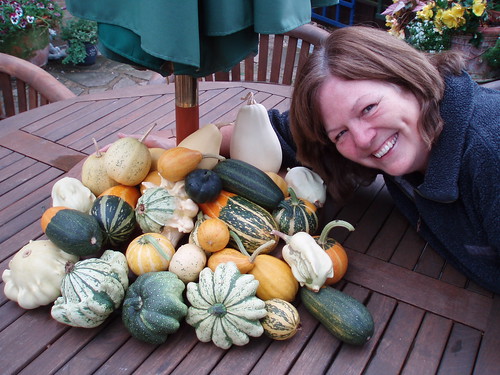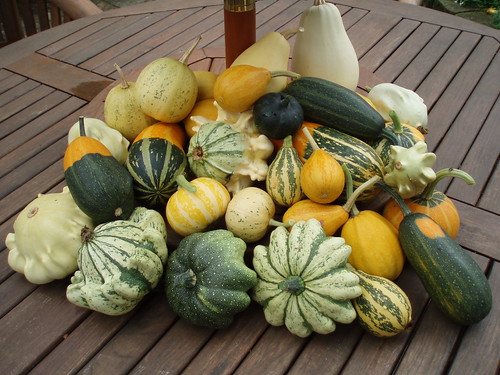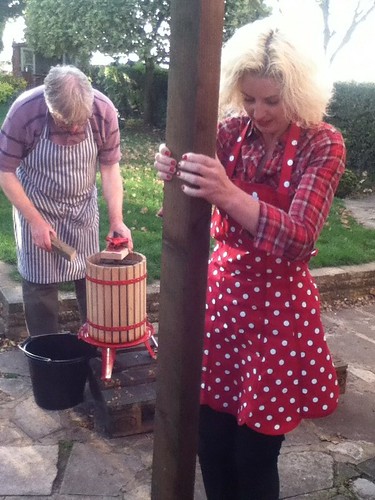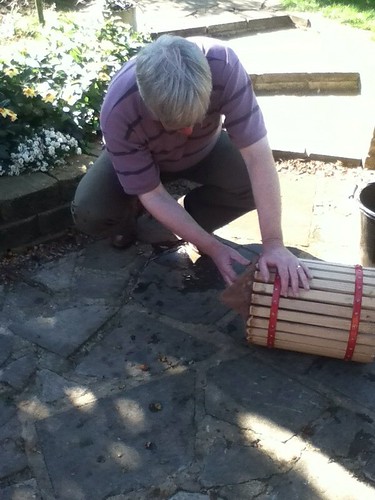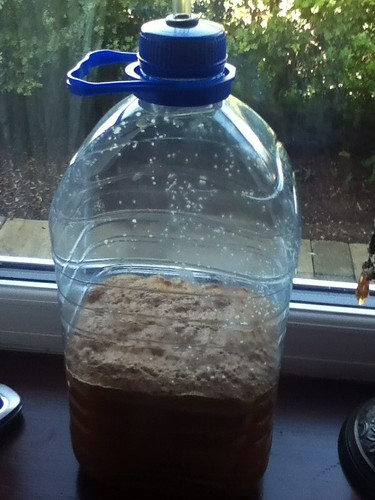I spend a lot of time on trains. I'm writing this on my laptop on a train. I have it perched on the small table that First Capital Connect provides for work or refreshment and there's a chap opposite who is sorting out a massive sheaf of papers. He's a bit resentful that I have some of the table and he's trying to nudge my laptop across a bit. I'm actually using less than my half of the table so I'm not giving way. I might try a sarcastic "have you got enough room?" if he carries on.
My train is full of fairly familiar faces but at 7am no-one feels especially sociable and so we tend to sit there plugged into mpv players, watching video on tablets, texting, reading Metro or sleeping. A few of us work, I'm either on my Kindle reading or tapping away on my laptop for either work or leisure writing.
I know many familiar faces, but few names. I observe people and people observe me. One chap asked me, out of the blue, why I wasn't coming on my motorcycle any more. He must have seen me wearing motorcycle boots. It turns our he had a Yamaha R1 and had commuted to London on it when he lived in Biggleswade. He'd moved to Peterborough and that was too far to commute by bike. There are a couple of other bikers, including a chap who has a BMW R1200 RT. I try to avoid him as he's a bit of a moaner and I once had to listen to a long conversation (pretty one-sided) about problems with his electronically-controlled suspension and how much it cost for new sensors and controls.
There's a chap called Gordon, who is very sociable. He runs the trade body for manufacturers of branded gifts - pens, flash-drives, mouse mats, mugs, etc.
Mostly there's little said, but on Monday we were stopped at St Neots and, when the doors closed, the train started going backwards. Everyone wondered what was happening. It stopped and then starting going forwards. "Must be a woman driver," the bloke next to me said. We all shifted. I said: "We all think that's funny, but none of us dare laugh."
Our little group then had half an hour's chat about political correctness, women drivers not being able to reverse, marriage and touch typing. I think Jack Wilshere's goal for Arsenal against Norwich might also have been mentioned.
There are some interesting looking characters on the train. The blonde girl who gets on at Huntingdon and who is always desperate to save a seat for the young man who gets on at St Neots. I'm not sure whether they are lovers or friends. They are tactile, but a little awkward. He gets off at Stevenage and then she goes to sleep. If she can't save him a seat, she gets up and stands with him.
There is a tiny woman with briefcase and Daily Telegraph who gets on at St Neots. She's like a terrier, she's always desperate to get a seat. She's in her forties I'd guess and she never wore make up. I think she might be a barrister and has a wig on all day, or she's an academic who has no time for such things. Her hair is always a mess and frankly, she often looks as if she's been dragged through a hedge backwards. Once she gets her seat, she'd open up a Daily Telegraph,scrunch it into a complete mess as she read it and then leave the badly folded pages in a crumpled heap on her seat. I never saw such a scruffy person. She always wants to be first out of the train as well.
About a year ago, her wedding rings disappeared and soon afterwards she started wearing lipstick (which she applied like she read the Daily Telegraph) and then she began talking to other women about nail care and hand-cream. It was astonishing. She's settled down now and tends to read highbrow books or her Kindle rather than the Telegraph.
Old Lady With The Tea gets on at Huntingdon and she must have been commuting for years. She gets a lot of respect from her fellow travellers, but I don't like it when she sits next to me because she always takes the lid off her tea and perches it on the little table. If it's going to spill it will be over my lap-top or my lap.
Misery Guts (that's Margaret's name for him) doesn't sit in my carriage, but we see him every morning walking slowly, painfully down the platform. He doesn't look happy (hence his nickname). He's in his 50s, quite fat and quite unhealthy. Once, we didn't see him for a few weeks and we thought he might have died, but then there he was again. Some fat people who walk slowly make you want to run up behind them and give them a push, get them moving a bit quicker, but you wouldn't imagine doing that to Misery Guts.
East European woman is an evening regular but I see her only rarely in the morning. She's small, smart and very pretty and her husband/boyfriend meets her every evening. He is waiting in the station foyer; he always looks pleased to see her and then he walk with her to where their car is parked. Often, I'd find myself walking behind them to my car where Margaret is waiting. She chooses to stay in the car rather than walk to the foyer to meet me (which is fine, I'm grateful for the lift), although just lately Holly has been included in the evening station run which means Margaret and Holly are waiting. Holly can't pick me out in the crowd and it's only when I approach that she recognises me and gives me a wag.
Thin Man with Raincoat and Rucksack was another Huntingdon regular, but I think he must have retired. He was a small chap and very thin with sharp features and hair that was grey with just a hint of ginger left. It was slicked back with plenty of product - Brylcreem, I suspect. He always wore a tweed jacket, a pale raincoat and always had a massive rucksack on his back. He was desperate to be first out of the train and would get up from his seat before Finsbury Park so he could be right up against the doors when the train stopped. We generally pull in on Platform 8, so the doors open on the right-hand side and it was a small pleasure for me when we were terminated at a different platform and the doors opened on a different side - he looked so annoyed. Thin Man was also a Victoria Line traveller and got off at Oxford Circus. He always wanted to be first on the tube as well and once on the tube, he'd stand there with his rucksack sticking out by a foot-and-a-half, reading the Metro and not holding on. His rucksack acted like a counterbalance and it was a bloody nuisance swinging around. It was amusing (on a crowded train) to give it a little sideways shove and put him off balance. Once, he tried to get on a really crowded train and his rucksack stopped the doors closing. That was a happy morning for me.
Notts Forest is a funny chap. He's getting on in years, but probably looks older than he is. He always wore a Nottingham Forest knitted hat and, once in his seat, he'd get his headphones on and go to sleep. Sometimes he'd snore really loudly. Last year, he got a girlfriend and she clearly set about giving him a makeover). The Forest hat was put away and replaced with an NY baseball hat (I said it was a makeover, not necessarily one for the better). His red Forest paddock jacket (XXL) was also consigned to the trash. Forest has a few work colleagues on the train and he started talking to them about his partner and the rock concerts they were going to. The romance lasted less than the close season; his Forest hat is back on his head and he's snoring away once more. I haven't seen him for a few weeks, so perhaps he's retired?
DT Man is tall, thin and a man of habit. He also likes his own space (and a bit of somebody else's). He gets on the train with a Starbucks' coffee and the Daily Telegraph, crosses one leg across his thigh so his foot's sticking right out and reads the Telegraph at a spread. No folding or scrunching for him; he has arms outstretched and the expanse of newsprint spread like a curtain providing him with space and privacy. It means I can read his newspaper from across the isle and his tactics normally mean that people are discouraged from sitting next to him or opposite him. If the Telegraph doesn't deter them then the Starbucks' cup on the edge of the table will. He's very grumpy when someone is in his place before he gets there and then moves across the aisle to my plot, plonks his Starbucks' on the table and puts up his DT screen. I don't mind that, but the coffee is a constant threat, placed near the edge and brushed from time to time by the newspaper. When the Huntingdon lot get on he has to rein himself in a little - and quite right too!
This Tuesday I stayed with Max and my commute moved from First Capital Connect to Southern Railways, Balham to Victoria via Clapham Common, Clapham Junction and Battersea Park. At Peterborough, I can always get a seat and generally choose the seat I want. From Balham, on the 7.15am you have no chance, it's like a tube train. Normally, you can grab a seat at Clapham Junction when loads of people get off to change trains, but this week, I was jammed in so tight, I couldn't get across in time. It wasn't a pleasant journey - someone had broken wind so there was a sulphurous smell, a chap next to me had his headphones on just a little too loud and there was an Asian guy right in my face, who conducted a phone conversation all the way from before Balham into Victoria. He said nothing all the way except "yeah" and an affirmative grunt, but I could hear a woman on the other end of the conversation talking incessantly. Amazing!



